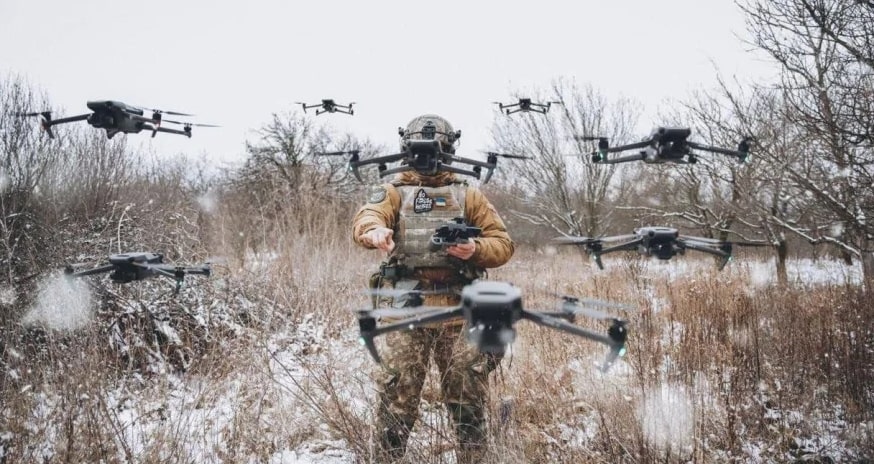Russia is catching up fast with Ukraine and has nearly reached the number Ukrainian FPV drone attacks. The number of FPV drone attacks on both sides is now approaching 2,000 per monthly.
On 6 February 2023 Ukraine’s president Volodymyr Zelenskyy created an independent branch of forces, the Unmanned Systems Forces, to consolidate and scale up previous successful tactics for the battlefield use of drones. In December 2023 he announced that he aimed to manufacture 1,000,000 drones in Ukraine by 2024. This goal is achievable for nearly 200 domestic manufacturers.
Similarly, Russia has also been introducing small drones to the army in large numbers, using its state-run military machine.
The Tochnyi OSINT report on FPV Drone Warfare shows that Russia is increasing FPV strikes, mirroring Ukraine’s approach. It has reached almost 90% of Ukraine’s frequency of this type of attack. The data gathered from open-source videos may not have captured every strike, but it does cover a large portion of them.
The report used data collected from August 2023 to 23 January 2024 in order to evaluate the use of FPV drones and Lancet drones. Overall, Ukraine maintained a certain dominance in the use of FPV over Russians. However, Russians have been developing drone production at a nearly equal pace with only a few short months of lagging.
How many FPV drones does Russia and Ukraine use each year?
Tochnyi’s figures show that between August 2023 and 23 January 2024, Russia had at least 2,889 drones in use, while Ukraine had at least 3,886. Despite this, Russia continues to increase its use of FPV-drones. According to the current trend, Russia will continue to match Ukrainian results when it comes FPV strikes. This shows that Ukraine must increase its manufacturing output and use more advanced technology to remain ahead of the technological race.
In December and January, Russian FPV drone attacks reached 80% and 82 % of the number Ukrainian strikes, compared to the 2- and 3-times Ukrainian advantages in the previous month.
The Russian and Ukrainian tactics for FPV drone strikes differ. The Russians are mainly targeting infantry and fortifications while the Ukrainians are mainly targeting vehicles and other military gear.
Both sides increased the number of FPV drone strikes on infantry, but the Russians put in more effort. In October 2023 the Ukrainians used FPV drones to conduct more strikes against infantry than did the Russians. This changed in December 2023, after Russia began to produce FPV drones at a large scale. The data excludes attacks that were carried out by reusable drones.
Ukrainian forces maintained a substantial advantage in the number FPV drone attacks against vehicles. The average daily number of FPV drone strikes against vehicles in Russia was 4, compared to 13 for Ukraine. This shows a clear advantage for Ukraine.
The Russians also increased their use of Lancet drones to target vehicles. Despite the high number of FPV strikes in Russia, the use of Lancet drones by Russia remained low. There were 248 total cases between August and December 2022. Of these, 202 were against equipment.
Lancet drones are expensive and should only be used against valuable targets such as artillery systems. The majority of videos released by Russians confirm this tactic.
The Russian army is also the leader in FPV attacks registered against defensive positions like concrete bunkers, homes, or trenches. Ukrainian videos rarely feature this type of strike.
Visual sources have documented Russia’s use FPV drones to destroy structures and cause the retreat of the defending forces. A FPV drone attack, for example, can cause a building to collapse at its weakest point and make it unusable as a defense position. This type of strike is not random but a Russian tactic. Evidently, Russia is attempting to destroy both recognized and potential defensive positions.
Drone tactics and vulnerability to drones
Drones can have a major impact on trench lines. Due to their high precision, they make trenches less effective. Drones are able to drop munitions in the trench and FPV drones even fly into dugouts. This raises the issue of how to protect trenches from drone damage.
Tochnyi analysts claim that the tactic is often used to combine artillery barrages and precision strikes using FPV-drones. This strategy is often used, especially in southern areas where there are many trench systems and trees running between settlements. Strategic artillery use disrupts enemy movements, forcing them into trenches. Once the artillery barrage has subsided, FPV strikes can be used to accurately target infantry in manned positions. This tactic was more commonly used by the Russians, while Ukraine had to use FPVs to make precision strikes because of a shortage of artillery.
Another tactic used in Ukraine, especially in Stepove, north of Avidiyivka is surveillance drones that guide FPVs to the target, in areas protected by houses or trees, where it’s easier for the enemy hide from a single FPV.
Protection of trenches
To protect against drone strikes, new tactics can include using metallic nets to cover overhead, surrounding obstacles like trees, or building trenches with higher embankments that will block the drone’s view and prevent it from entering the trench.
A second vital tactic would be to use less manned sandbags and to employ an area defence strategy that takes advantage of the strengths of a tightly-coordinated defensive operation. This would allow forces to consolidate and reorganize and then transition to other tactical maneuvers such as offensive maneuvers. Quick reaction force methods could be used more often to reduce the need for densely-manned trenches. This could be complemented by the introduction of unmanned and remote controlled firing positions.
UAVs can be protected by a number of passive methods that reduce the risk of detection. Camouflage, deceptions, dispersions, displacements, and protective structures are all possible. These are the ones to consider for shielding units from detection.
Even factors like shapes, patterns, textures, and shadows can make a unit vulnerable to FPV drones. The trench lines southwest from Robotyne are a bad example. These trenches are intricate, but they have no cover. Recent FPV videos by Russians operating here make them very visible.
A simple surveillance drone is able to assess the composition of the force within the trench with ease, allowing for targeted FPV precision attacks.
The best way to conceal a trench is by keeping it well-maintained. You can also use netting and other materials to conceal the trench. Another method is to use trench target decoys as a deception. The deployment of trench decoys can divert the attention and create uncertainty in FPV operators. This would reduce the number of drones that the enemy has and reduce attacks against real targets.
Read more about:
* Study shows drones are the most cost-effective and effective way to fight Russian invasion
* Can Ukraine maintain its asymmetrical advantage in the drone war?
* Russia plans a 68% increase in military spending by 2024, surpassing Ukraine’s defense budget by 2.5 times
* Ukraine launches mass production of jam-resistant drone
* Minister: Ukraine produces tens thousands of drones each month
* Ukraine deploys 2,000 drones manufactured in Ukraine to the most critical fronts of war
Read More @ euromaidanpress.com




